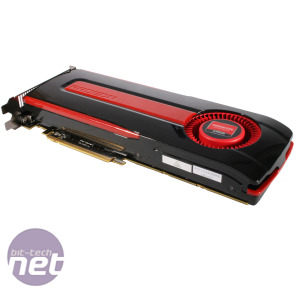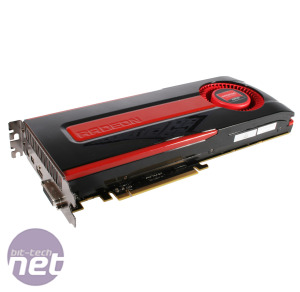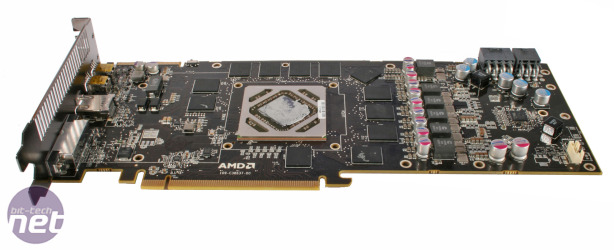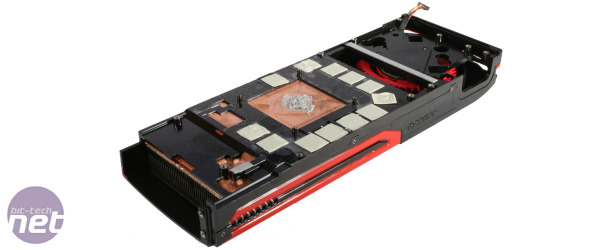
The Card
Like all of AMD’s recent high-end cards, the HD 7970 3GB is a dual-slot card, and it’s once again been finished in Adam-West-era-Batman red and black. The glossy finish and slick styling of the stock cooler certainly look a lot better than the black-box designs of the HD 6800- and HD 6900-series, though.As far as stock clock speeds go, a GPU frequency of 925MHz and a memory frequency of 1,375 MHz (5.5GHz effective) get us started, but AMD claims there’s plenty of overclocking headroom to be had too.
Measuring 275mm long, the HD 7970 3GB is the same length as the Radeon HD 6970 2GB that it usurps at the top of AMD’s single-GPU range. Like that card it also requires one 6-pin and one 8-pin PCI-E power connector, located on the top of the card. Meanwhile, the radial fan is designed to draw air in from the side ventilation ports and then exhaust it out of the rear of your PC’s case, with the rear I/O of the card oddly spartan.
There’s a single DVI output, a pair of Mini-DisplayPorts and an HDMI output, leaving half the rear I/O for ventilation duty. All four display outputs can be used simultaneously, and AMD claims the card is able to support up to six displays via a (not yet released) DisplayPort splitter. While the loss of a second DVI port will likely worry current multi-monitor users, remember that DisplayPort to DVI adapters can be had for less than £10.
Along with being the first 28nm GPU to market, the HD 7970 3GB is also the first PCI-E 3.0 graphics card. While the doubling of PCI-E bandwidth to 32GB/sec is certainly intriguing, no current CPUs or chipsets support PCI-E 3.0. As such, this is a feature that’s impossible to test at the moment.
Removing the card’s stock cooler reveals that the GPU is housed in a metal enclosure, although whether this is to stop it being crushed by the mounting force of the cooler (or a third-party cooler or waterblock) we can’t be sure. Five power phases supply the GPU, with an individual power phase for the memory, resulting in a total of 6+1 power phases. Intriguingly, there’s also space for an additional power phase on the PCB that AMD has chosen to leave off; could we perhaps see an even faster version of the card in the future?
The cooler itself utilises a vapour chamber attached directly to the stack of densely packed cooling fins, rather than an assembly of heatpipes to transfer heat away from the GPU and into the cooling fin stack. The cooler also includes a black aluminium plate, which helps to cool the card’s 12 memory modules, while the power delivery circuitry, situated directly beneath the radial fan, has no direct cooling.
PowerTune and ZeroCore
AMD’s PowerTune technology returns for the HD 7970 3GB and it’s once again handled by hardware on the card rather than in the driver software (unlike Nvidia). For those unfamiliar with PowerTune, it’s a technology to work around stress-test applications such as FurMark, limiting the default frequency of the GPU. Such applications put the GPU under maximum load conditions, but the vast majority of games don’t come close to doing the same. PowerTune dynamically adjusts the card’s clock speeds in such applications, allowing for higher clock speeds in games, but lower frequencies, temperatures and power draw in stress-test applicationsIn addition to PowerTune, AMD has also introduced ZeroCore with the HD 7970 3GB. This technology primarily applies when the operating system stops outputting a video signal, such as when it puts a display to sleep. When this happens, the GPU is able to enter a standby mode, only leaving the PCI-E bus switched on and dropping idle power consumption to incredibly low levels. Previously, even if your screen was off, the GPU would still be ticking over.
Intriguingly for multi-GPU users, ZeroCore also applies with CrossFire setups. When displaying a Windows desktop, AMD claims that any secondary cards will enter a ZeroCore state, reducing their power draw to a few Watts until you need them.

MSI MPG Velox 100R Chassis Review
October 14 2021 | 15:04












Want to comment? Please log in.